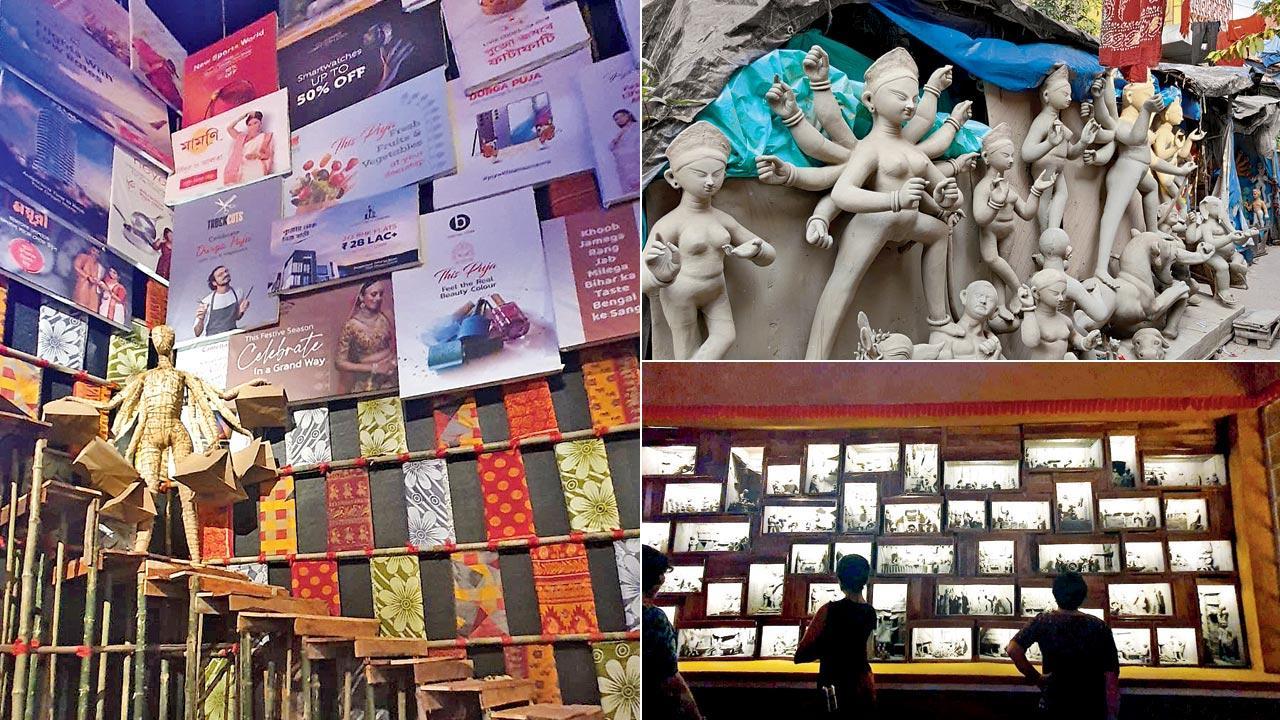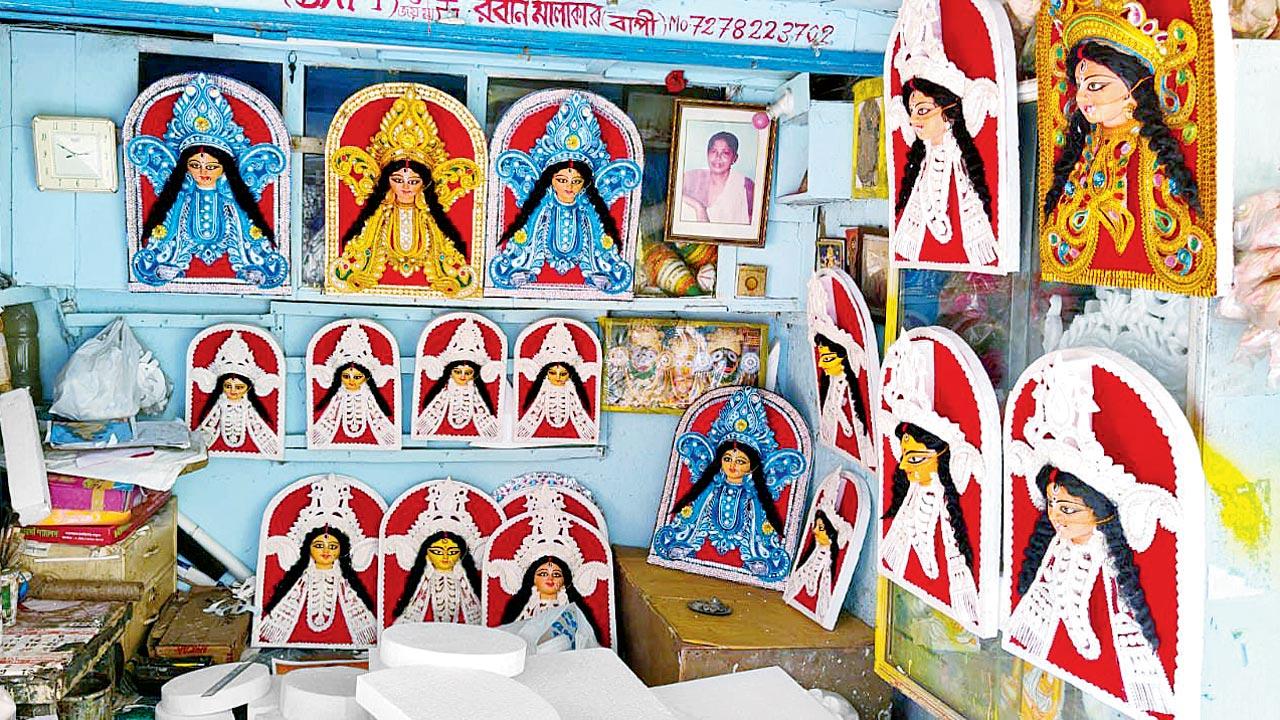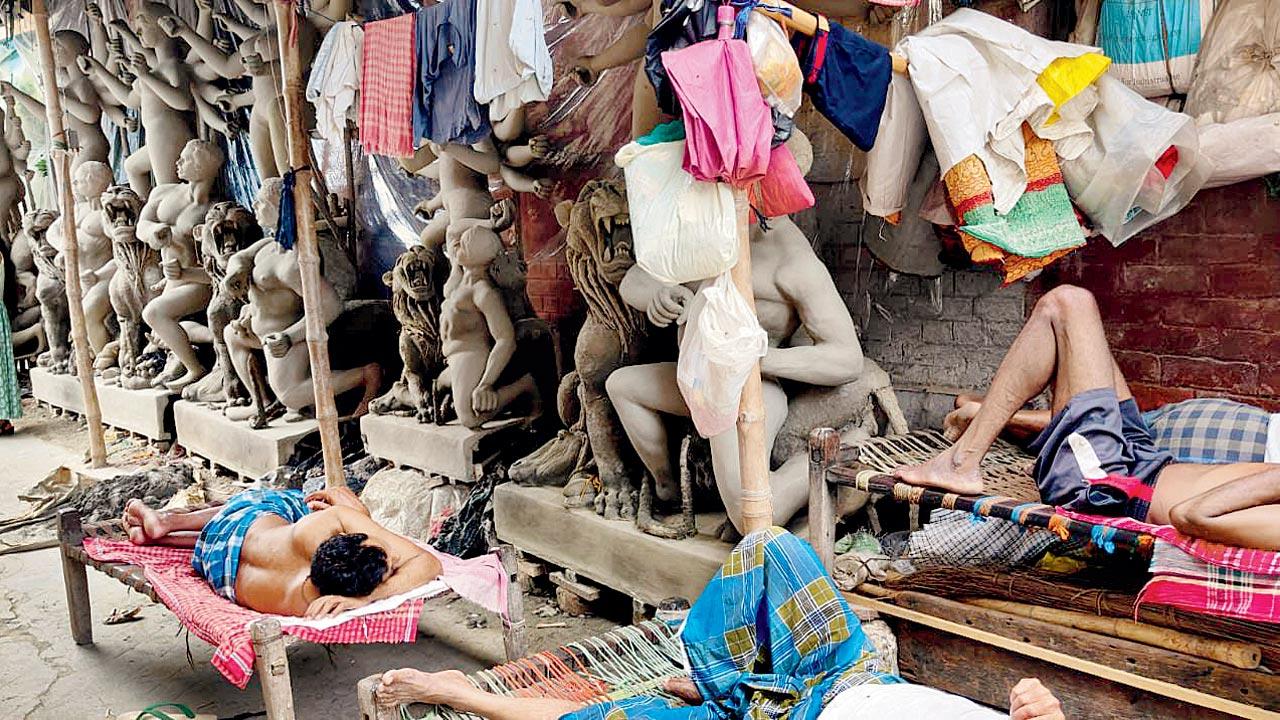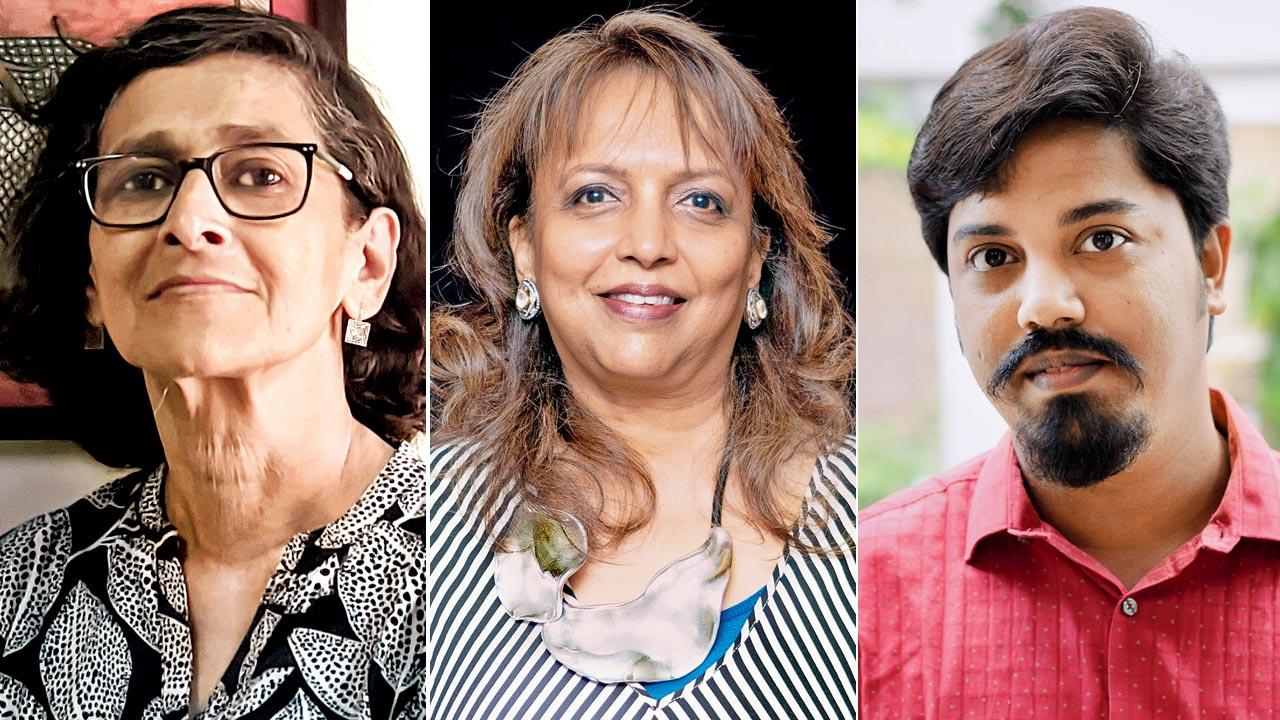As Bengal gears up for its biggest annual celebration, mid-day assesses the economic and political implications of its nascent UNESCO recognition

MassArt, a non-profit organisation conceived in June 2022 with the objective of promoting the art and culture of Bengal, has joined hands with UNESCO and the British Council to present a preview show of Durga Puja art in a sort of early glimpse into the public art festival before the gates open for the masses to worship
A lot of the time, the coveted intangible cultural heritage tag is given to those performing arts which are dying out or to niche community events. For instance, it has been given to Buddhist chanting in Ladakh, and the ritual singing and drumming [sankirtana] of Manipur. The Durga Puja, however, is a thriving festival that continues to grow and develop in new directions 400 years after it was believed to have first been celebrated in Bengal by Raja Kangsanarayan of Taherpur in present day Bangladesh. So, while it may not strictly need protection, it has certain aspects that need safeguarding,” historian Tapati Guha-Thakurta tells mid-day about why the annual festival needed the UNESCO tag in the first place.
The former director and honorary professor at the Center for Studies in Social Sciences, Kolkata, whose book on the Durga Pujas of contemporary Kolkata was published in 2015, spearheaded the research that ultimately put the festival on the UNESCO Representative List of the Intangible Cultural Heritage of Humanity in 2021. In August 2018, Sangeet Natak Akademi, a nodal agency under the Ministry of Culture had approached Guha-Thakurta to prepare a dossier to send to UNESCO based on her decades-long research.
She believes that what needed safeguarding was not just the religious or ritual purity aspect, but also checks against other factors like excessive commercial clutter, noise and light pollution, threat to the green cover of the city, safety hazards, and certain social and community guidelines. This was especially so because this was a space of community, goodwill and amity, and the above needed to be respected. “It’s [the tag] not like getting a prize. It’s about recognition. I had said that the UNESCO honour will bring international visitors [to Bengal]. What’s also important is that if you want to make it a world-class event, you must have world-class facilities. Kolkata doesn’t. So, this was an opportunity.”
Mukul Agarwal, founder-trustee of a voluntary citizen’s initiative called Calcutta Heritage Collective also speaks of how there is now a greater need to be more particular about cleanliness and hygiene. “There is the hope that there will now be better arrangements.” Advertising billboards covering houses block footpaths and streets adhoc. “It’s a mess once the festival is over and we use so much plastic. These two aspects, we were hoping that the UNESCO tag would help to change.”

While experts acknowledge the ephemeral and thus, intangible aspect of the celebration, it also involves mammoth material production. But because very little of it gets preserved and each year, it’s more about starting yet another cycle of renewal and rebuilding, “It feeds the economy, offering livelihood to thousands. It is income generating and supports all kinds of people. All of this meant that the festival met the criteria. The contemporary and the transforming nature of the phenomenon makes it one that’s keeping up with the changing times, changing demands, changing gender roles and newer caste identities,” Guha-
Thakurta explains.
It has also grown to become inclusive. She offers the example of members of Jharkhand’s Asur tribe, who look upon demon Mahishasur as an ancestor and hence, see Vijaya Dashami or Dussehra as a day of mourning, now being included in the Puja festivities. Another Kolkata puja was planning to bring acid attack victims to a sindurkhela event, she shares. These she sees as conscious socially-driven gestures that the puja has integrated.
“The UNESCO tag has acted as a catalyst to make the people realise the importance of Durga puja. Besides, it also has immense potential to become Kolkata’s annual public arts festival. The identity of the city and the festival have always been synonymous, much like in the case of the Kochi Biennale. This is something that could have happened only if it had the international tag, which means it holds significance not just for the Bengalis, but for the people of Kolkata,” says PhD scholar Sandipan Mitra who has worked with Guha-Thakurta on the dossier.
There is also the financial aspect, he highlights, where the tag promises to attract international tourists, which could end up contributing to the economy of Bengal (Durga Puja accounts for 2.58 per cent of the state GDP). “The tag gives a kind of visibility to the Puja at the international level. So, we are very clear that it doesn’t have to do with [just] the local people.” Mitra cites how this has begun to happen since 2021 with stories of artists like 75-year-old Chalchitrakar Reba Pal coming to the fore. For over four decades, the veteran has been creating the circular painting canvas that sits behind the idol and has a history dating back 300 years, for over four decades.
 Kumortuli, the famous traditional potters’ quarter in northern Kolkata, is abuzz in the months leading up to the festival. Pics/Karan Shetty
Kumortuli, the famous traditional potters’ quarter in northern Kolkata, is abuzz in the months leading up to the festival. Pics/Karan Shetty
The astonishing creativity on display during the festival cannot be ignored. “These are not people who will become famous for this work, but they get paid a fee and I think for the art community, Durga Puja has been very enabling because you don’t need famous artists. If you have done good work, you’ve got a few awards, you’ll be invited to work. It feeds the turnover of artistic production and not just the decorator firms or potter’s workshops but all kinds of people. It’s really now almost like a professional business.”
While trade insiders estimate at least 17,000 foreigners are likely to take part in the festivities this year, the state government has told the industry to be ready to host five lakh visitors this festive season, according to a report in The Times of India. “This time, tourism stakeholders have a targeted reach of inbound tourists. We recently interacted with 900 operators at the national convention of Indian Association of Tour Operators (IATO). The tourism department has arranged 65 Puja packages for tourists,” the State Tourism Secretary Nandini Chakravorty is reported to have said.
Since it is a time for getting together, cultural events, feasting, buying and selling, it has always had a global profile with a single community, Guha-Thakurta observes. Many livelihoods revolve around it and it supports countless people in the food and beverage and hospitality industry, transport, even electronics and equipment. “That’s a lot for a state which has barely no industry.”
But, she wonders why there isn’t the same kind of buzz around the recent Shantiniketan recognition. It is in a way a niche institution, a tangible place and which is truly endangered now. The state’s investment there should have been very high.” The reason, she conjectures, is that the Durga Puja is a mass festival. Coupled with the hunger for international recognition, the talk about economic and creative livelihood is coming partly as a defence mechanism because there was equal talk about wastage of expenditure in the ‘60s and ‘70s when there was criticism of the spectacle aspect of it.
 Tapati Guha-Thakurta, Mukul Agarwal, Sandipan Mitra
Tapati Guha-Thakurta, Mukul Agarwal, Sandipan Mitra
“I don’t see a qualitative change,” the historian says about the last two years. “Yes, more scale, more money, more publicity. Publicity is very high, excessively high sometimes, I think. Everybody [involved] has a social media page. There was no documentation at the time when I started my research. Now, there is conscious videography. Certainly, more and different kinds of people are coming to Kolkata and the pujas. That’s been the big change over the last three years.”
An example of an initiative that has begun to cater to increased tourists is a preview show of Durga Puja art undertaken by MassArt, a non-profit organisation conceived in June 2022 with the objective of promoting the art and culture of Bengal, with UNESCO and British Council, a ticketed event allowing people to see the art on display a few days before the crowds begin. Some Puja clubs are being told to get the pujas ready in advance and the money from the tickets is going to the pujo committees that have agreed to work on these planned previews. “I think it’s been good, because it allows in anybody who wants to see,” notes Guha-Thakurta. “That way, they are also separating what they’re calling the artistic part of the festival seven days before the worshipping leg kicks in.”
Unique experiences to savour in Kolkata during Pujo
Bonedi bari pujos: Visit traditional grand celebrations of the goddess in aristocratic households with pujas dating back hundreds of years and passing down generations at the Sovabajar Rajbari, Laha Bari and the Jorasanko Daw Bari.
Kalabou/Nabapatrika (Banana Bride) on Saptami: This ritual involving the worship of nine different plants, collectively known as Nabapatrika, was originally a popular ritual performed by peasants for a prosperous harvest. Later, when Durga Puja became a popular autumnal festival, the nine holy rituals of the Nabapatrika were added to its ceremonies.
Kumari (kanya) Puja at Belur Math: Since 1899 when Swami Vivekanda started the tradition, Ramakrishna Mission, Belur Math, has been celebrating the Mahaashtami with Kumari Puja, in which a girl younger than seven-eight years is worshipped as the Mother Goddess.
Maha Thali at Bengali restaurants: Gear up for a week of gastronomic extravaganza with festive spreads at renowned Kolkata eateries like Oh! Calcutta, Kewpie’s, 6 Ballygunge Place, Aaheli and Bhojohori Manna.
Cocktails at Ølterra pub, Park Street: Explore Ølterra’s In Search of Bengal cocktail menu which takes you around different regions in West Bengal with drinks like Aparajito where Kolkata’s gondhoraj ghol or Bengali-style buttermilk is paired with vodka; Hastoshilpo which bridges the flavours of Burdwan and
Bankura to create a Jim Beam black aged in earthenware with ghee-washed gobindobhog rice syrup and served with mihidana, or The King of Nature which brings in the flavours of Jalpaiguri, Cooch Behar and Alipurduar with a gin-based drink infused with jalpai chutney and panchphoron fizz.
The grand immersion: There are boat cruises that offer glorious views of the immersion of the idols on the Ganga on Vijaya Dashami. The Ichhamati river (which flows through India and Bangladesh) in Taki, a border town about two hours by road from Kolkata, also becomes the site of a unique spectacle on the final day of the Puja when residents from both sides of the border arrive with their idols for immersion.
 Subscribe today by clicking the link and stay updated with the latest news!" Click here!
Subscribe today by clicking the link and stay updated with the latest news!" Click here!










